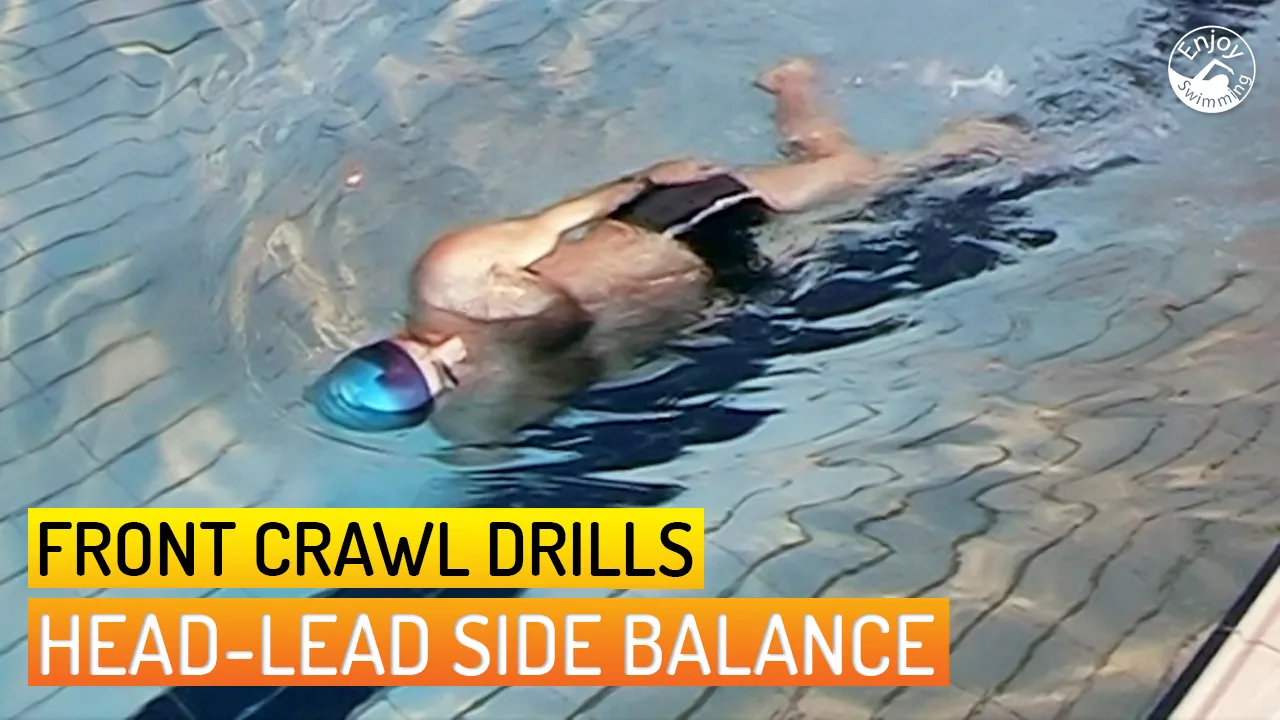Head-Lead Side Balance is one of our swimming drills for the front crawl/freestyle stroke. As the name suggests, the focus is on improving your balance as you swim on your side.
Head-Lead Side Balance follows Head-Lead Prone Balance and precedes Head-Lead Nose Up/Node Down in our series of swimming drills for the front crawl/freestyle stroke.

If you watch seasoned swimmers perform the front crawl, you’ll notice that with each arm stroke, their bodies rotate from side to side around the longitudinal axis.
This allows these swimmers to better use the chest and back muscles of the pulling arm, and also facilitates the recovery of the other arm.
Accordingly, a swimmer should also be able to balance their body while floating on their side and feel comfortable in this position.
For this reason, in this drill we will practice balance while floating in the lateral position (i.e. on your side).
Swimming Drill Video
The following video demonstrates Head-Lead Side Balance:
Swimming Drill Instructions
The initial position is the same as the one you practiced in Head-Lead Supine Balance:
- Float on your back in a horizontal position.
- Keep your head and body in a straight line, with your face turned toward the ceiling.
- Keep your arms at your sides and perform a compact flutter kick.
- Lean on your upper back to maintain balance and prevent your hips and legs from sinking.
Once you feel comfortable in this position, do the following:
- Roll onto your side while keeping your arms at your side and your head facing upward.
- Ideally, your upper shoulder, arm and part of the hip should be visible above the water.
- Roll as far as you can while still feeling comfortable floating on your side. (How far you roll depends on your body shape.)
- If you notice that your hips and legs are sinking, lean onto your lower shoulder to bring your hips and legs back up.
- Maintain this lateral position and continue to flutter kick for the remainder of the length.
- Change sides with each length and continue to practice until you feel comfortable floating on either side.
Sweet Spot
Floating on your side may feel awkward at first. It takes time and practice to be able to maintain balance in that position.
Also, how far you can roll and maintain balance while feeling comfortable depends on your morphology. Total Immersion calls this position where you can comfortably float on your side the Sweet Spot.
Additional Tips
Here are a few additional tips for practicing this swimming drill:
- You will most likely find that you float better on one side than on the other. This is common. Just practice a little more on your weak side to compensate.
- Use swimming goggles to keep water out of your eyes.
- You can also use a nose clip to stop water getting up your nose.
- It is okay to use swim fins if you have a weak flutter kick.
Learning Path for the Front Crawl
Below is an overview of our series of articles on learning the front crawl. Each article in this series contains one or more drills that have to be mastered. The current article is highlighted:
Once you have gone through all the steps of this learning path, you should be able to swim front crawl without any problems.
Good luck!

Iolanda
Thursday 13th of April 2017
Thank you so much for these drills. I am a beginner and they have made a big difference in my technique.
I struggle with bilateral breathing and by doing this side balance drill, I noticed that on my weaker side, I tend to sink a lot, more making it difficult to catch a breath on this one side.
Do you know why this could be and do you have any tips for improvement - or is just all about practicing?
Christophe
Sunday 16th of April 2017
Most people have a weaker side when floating in the water, or breathing in the front crawl, for the matter.
My theory for this is that as the left lung is smaller than the one on the right side, the buoyancy on each side of the body is different.
However, I think with enough practice, we are able to compensate for this weakness.
Good luck!
Grahame
Thursday 22nd of December 2016
Excellent advice, watching and reading this series has taught me ways to improve my swimming skills. Flutter kick has improved as well as breathing.
Thank you four your series of articles and videos.
Christophe
Monday 26th of December 2016
Thanks Grahame!